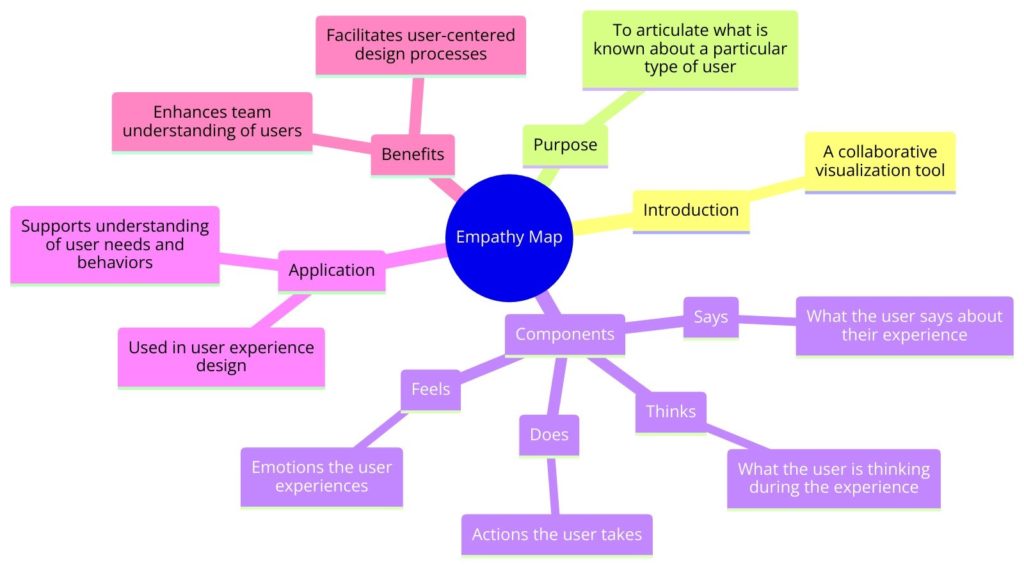Empathy Map
The Empathy Map is a collaborative visualization tool used to articulate what we know about a particular type of user. It externalizes knowledge about users in order to 1) create a shared understanding of user needs and 2) aid in decision-making. Developed by Dave Gray, the founder of XPLANE, the Empathy Map has become a fundamental element in user-centered design and user experience (UX) design processes, helping teams gain deeper insights into their users’ minds.
What is an Empathy Map?
An Empathy Map is divided into several sections (typically four quadrants), each representing a different aspect of the user’s sensory experience. It is centered around a user persona and captures what the user Says, Thinks, Does, and Feels. The goal is to build a common understanding of the user’s needs beyond demographic and biographical data, focusing on emotional and psychological elements that drive users’ behaviors.
Origin of the Framework
While the concept of empathy is not new in design thinking, the Empathy Map as a formal tool was developed by Dave Gray and has been popularized through its inclusion in various design and innovation methodologies, including those promoted by IDEO and Stanford University’s d.school. The tool has evolved over time, with different versions expanding on the original format to include additional sections like Pains and Gains, further enriching the understanding of the user experience.
How It Works
The traditional Empathy Map consists of a central user persona and four quadrants:
- Says: Quotations and direct statements made by the user.
- Thinks: What the user thinks throughout the experience might be different from what they say out loud.
- Does: Actions the user takes in the context of the experience being analyzed.
- Feels: Emotions the user might be experiencing, often inferred from what they say, think, and do.
Teams typically create an Empathy Map by compiling observations and insights gathered from user research, such as interviews, field studies, or diary studies, onto a large poster or whiteboard divided into quadrants. The process is collaborative and involves discussion and consolidation of viewpoints to ensure a shared understanding of the user.
Why It Is Valuable
The Empathy Map is valuable because it:
- Helps teams move beyond stereotypical assumptions and develop a nuanced understanding of their users.
- Facilitates cross-disciplinary understanding and alignment of user needs within a team.
- Provides a clear, visual reference that guides the development of user-centered products, services, and experiences.
- Supports the identification of users’ pain points and opportunities for innovation.
When and How to Use It
Empathy Maps are useful at the early stages of the design and development process, particularly during:
- User research and persona development to synthesize and communicate findings.
- Ideation sessions to ensure solutions are grounded in user needs.
- Any point where a team needs to refocus on user-centered design principles.
To create an Empathy Map:
- Gather all necessary materials, including a large poster or whiteboard, markers, and sticky notes.
- Draw the Empathy Map template, labeling the quadrants accordingly.
- Populate each quadrant with insights from your user research. Use sticky notes to facilitate adjustments and discussion.
- Discuss and analyze the completed map to derive actionable insights and identify design opportunities.
Shortcomings/Criticisms
While widely used, the Empathy Map is not without its shortcomings:
- Accuracy: The quality of insights generated from an Empathy Map heavily depends on the depth and breadth of the underlying user research.
- Simplification: There’s a risk of oversimplifying complex user experiences into a few observations.
- Bias: Teams may project their biases onto the map, misinterpreting users’ thoughts, feelings, and actions.
- Dynamic Nature of Users: Users and their environments are dynamic, but the Empathy Map is a static snapshot, which may quickly become outdated.
The Empathy Map is a powerful tool for fostering empathy and understanding users in a nuanced way. When used effectively, it can significantly enhance the design process, leading to products and services that truly meet users’ needs. However, it should be used as part of a broader user research strategy, supplemented by continuous engagement with users and iterative design practices.


